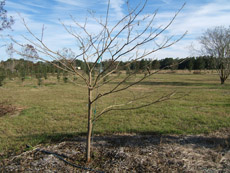Tabebuia umbellata (Yellow Trumpet Tree)
*Click on picture for more images of this species.
- USDA Hardiness Zone: 8B - 11
- Mature Height: 25 to 35 ft
- Mature Spread: 25 to 35 ft
- Growth Rate: Moderate to fast
- Availability: Becoming more available
- Drought Tolerance: Moderate
- Salt Tolerance: Moderate
- Light Requirements: Full sun for best flowering
- Native Origin: Not native to North America. Invasive potential has not been assessed.
- Soil Drainage: Needs a well-drained site.
- Foliage: Semi-green to deciduous tree with no showy fall color.
- Flowers: Yellow, very showy flowers in late winter.
- Pests: Free of serious pests and diseases.
Description: An ideal patio, specimen, or lawn tree, Yellow Trumpet Tree is often seen as a small, 15 to 25-foot-tall tree but can potentially reach taller, with a rounded, spreading canopy in a wind-protected area. Sometimes evergreen but most often deciduous, Yellow Trumpet Tree has four-inch-long silvery-green leaves with tan, fuzzy undersides. These leaves drop as new foliage emerges in spring, and it is at this time that the trees put on their heaviest flowering display, the trumpet-shaped, bright yellow blossoms appearing in dense 2.5 to 8-inch-long terminal clusters. . The eight-inch-long seed capsules which follow are brown, hairy, and persist on the tree through the winter.
Yellow Trumpet Tree is very useful as a median street tree for its vivid flower display, asymmetrical habit and drought tolerance. Once established it can survive on rainfall alone and produce an excellent flower display each year. It also makes a nice tree for planting close to the patio or deck where it will cast a light to medium shade below the canopy.
A native of tropical America, Yellow Trumpet Tree can be grown best in full sun on any reasonably fertile soil with moderate moisture. Prune to create a dominant trunk well up into the canopy by reducing stems that compete with the leader. Trees planted with circling roots often lean or fall over as they mature. Be sure to remove the circling portion of the root system prior to planting.
Gainesville Observations: Trees flower very well and they are beautiful in all years in Gainesville. Circling roots on our trees are slowing establishment and are contributing to instability of the trees. Trees can be pruned fairly easily to a dominant trunk but the canopy can be open following this necessary treatment. Trees grow well clear down to Homestead. Trees are similar to T. chrysotricha.


